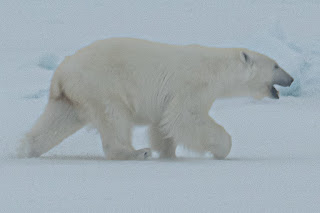This morning was particularly cold, but the wind was not so strong. I put my base layer on and my boots and opened up my tent to see that even with the outer flap closed, the snow had blown into the vestibule. I'm glad I brought my boots in! I put some outer layers on the bottom, laying my middle layers on top and headed to the bathroom tent. It was still standing, thankfully. Then, I grabbed my outer layers and headed to the dining tent to finish dressing. The guides seemed to sleep in this morning, which meant the generator didn't start till late which meant there was no heat in the dining tent until later. But as people woke up, body heat started warming up the tent. One of our group took pictures of the tents with snow on them this morning. I didn't. I was too busy trying to not get cold while getting dressed and going to the bathroom! It did snow a little, but most of this was blown up by the wind!

While we were eating our breakfast egg burritos, someone from a neighboring camp came by the let us know a polar bear was in the area, having just walked through their camp! Considering how vicious polar bears can be, my hat's off to those guys for not shooting him while in the camp! He could be seen by the spotting scope from our camp, and Ken estimated that he was probably just over a kilometer from us. We all hurriedly loaded on the komatiks and took off after him. Polar bears usually give full camps a wide berth because they don't like groups of people. They will quickly attack individuals, but groups are a different story. Our goal, aside from getting good pictures, was to scare him away from camps with the Skidoo engine noise. We succeeded, and we took lots of pictures while we herded him toward the floe edge. The guides estimated him to be about a 4-year-old male, only weaned for a short while.
My first look at him, he was behind some drifts.
You can see his gait while he was running.
He slowed down to a fast walk. We were driving, so lots of shaking.
We would move him toward the floe edge, then stop and watch him for a while. If he started trying to turn away from the water, one of the guides would maneuver their Skidoo and komatik to cut him off and set him back on the right direction.
When I first looked at these pictures, I thought he had a stick stuck to his tail, but I couldn't figure where he got the stick. When I went back through all the photos and looked at the progression, I realized, he had to do his business! I would probably be growling under similar circumstances!
Once he got close enough to the water, we left him alone. He saw a ringed seal and ran toward it, but it ducked down into its hole before he got there.
The guides said they swim well, but they don't hunt well in the water. It would have been nice to watch him navigating the brash ice, but we had already made him anxious enough and reinforced the idea that he should be afraid of groups of people. We didn't need to continue just for our entertainment.
We went to a spot on the floe edge where he was not likely to go. The brash ice had been blown in close to the edge, so not much hope that narwhals would come in. We saw some birds and a couple of ringed seals. I talked with Nina, our only woman guide, who described how they Inuit hunt seals. They like to eat all parts of the seal, including the brain, so they don't shoot it. They stand quietly by a seal hole and wait for the water to start rocking up and down. That signifies that a seal is about to come up to the ice. As it comes up, you quickly hook it with a large hook you hold in one hand while hitting it over the head with the other hand. They usually just use their hands.
Glaucous Gull. These are one of the largest gulls.
Ringed seal
Thick-billed Murre
Glaucous Gull
Ringed seal
One of our guides had a drone that he sent out looking. There were narwhals in the area, but they weren't coming in from the brash ice. These are the shots he got with his drone.
After lunch of a rice noodle soup and sandwiches, we moved to another location. There was still a lot of brash ice there, too, so I didn't even get out of the komatik this time. Got some more bird shots.
Red Phalaropes
Glaucous Gulls and a Black-Legged Kittiwake
Thick-Billed Murres supposedly headed to the migratory bird sanctuary on Bylot Island
On the way back to camp, we stopped by a seal hole to get a good, close look at one. We were almost all very curious, and the guides were happy to sate our curiosity whenever they could!
The brown things in there is fur that gets scraped off when hauling out of the water or dropping back in.
One of our group sent a GoPro down the hole to see what was there, but it was just dark water. Nothing exciting.
We finished going back to camp, and Nina wrote all of our names in Inuktitut, the local native language. I'm going to mount it onto some magnet paper and put it on the refrigerator!
And for our last dinner in camp, she and Elisha made a delicious dinner of Arctic char, rice pilaf, mashed potatoes, and carrots and brocolli.
Following dinner, photo dumping, and some chit-chat, I headed to the painful crawl into my tent for the last time!
































No comments:
Post a Comment